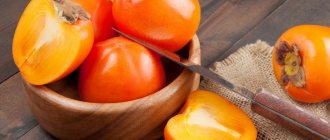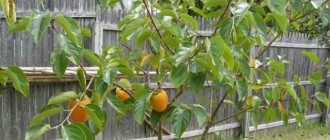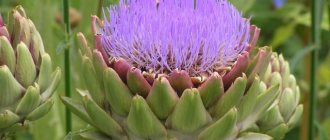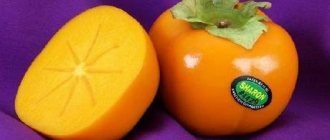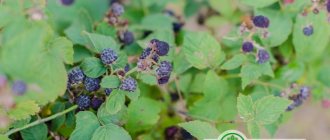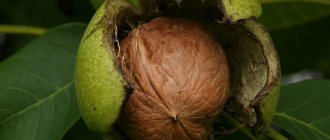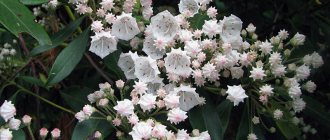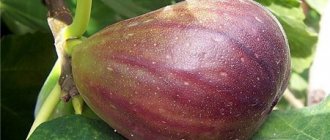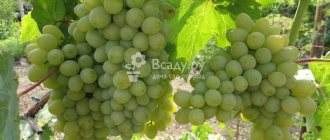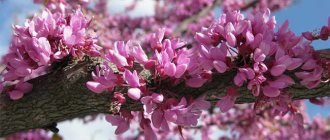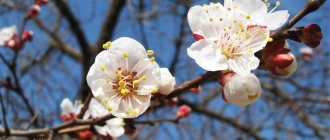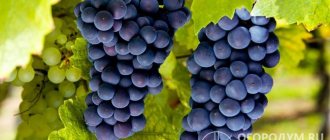Ask any Russian to name a winter fruit - and you will definitely hear: persimmon. In the Caucasus, it begins to ripen at the end of autumn. And whoever was there at that time was probably amazed - the trees were very impressive. It's a pity they don't grow here.
Do you still think so? In fact, persimmons can easily be planted in central Russia. But not the eastern persimmon, which bears fruit exclusively in the south, in warm regions with a mild climate (its frost resistance is low, it can withstand a maximum of -17 °C), but its relative, which can survive down to -35 °C! This is Virginia persimmon.
It is found in the wild in North America, in the American states of Virginia, Connecticut, Texas, and Florida. It is a monoecious or dioecious deciduous tree.
- What varieties of persimmon are suitable for the middle zone and Moscow region
- Where and how to plant persimmons
- How to care for persimmons in the middle zone? Do I need to cover it for the winter?
- How to form persimmons in the middle zone
- When does persimmon begin to bear fruit?
Where and how to plant persimmons
Persimmon does not tolerate transplantation well; damage to the roots can lead to its death, so you need to buy seedlings in containers.
It is better to plant Virginia persimmon in areas protected from the wind. The ideal option is on the south side of the house or a high fence. The hole is dug 2–3 times larger and deeper than the volume of the container. It is filled with a mixture of soil taken from this hole and leaf humus (the ideal option is rotted litter next to the trunks of pine trees growing on the sand) in a ratio of 1:2.
The seedling must be removed from the container very carefully so as not to damage the roots. It is placed in the center of the hole, covered with prepared soil, compacted well and spilled. Then mulch with hay, straw or freshly cut grass.
persimmons in the garden in autumn
Persimmon - moving north
Almost all gardeners in the northern regions dream of having a fruit-bearing persimmon tree in their garden. Today this is already becoming real. The topic will be important to every gardener who wants to diversify his garden with fruit and berry crops as much as possible, because persimmon fruits are rightfully considered the most nutritious fruits of the temperate zone. Of the entire diversity of the genus, we will consider the two most popular and promising species.
Will Pollard / Flickr.com
Description. Oriental, or Chinese, Japanese persimmon (Diospyros kaki) is a subtropical deciduous tree up to 12 m tall and with a wide crown, with a pronounced seasonality. The root system is deep, taprooted, and the roots are black. Often, novice gardeners, when replanting persimmons, get scared, thinking that the entire root system is black and has died. Leaves up to 20 cm, dark green, broadly lanceolate, sometimes corrugated and pubescent. Leaf fall in October with yellow or red leaves (looks very decorative). Growth 25-30 cm. Flowers are small, about 1.5 cm, usually yellow-white or green-yellow.
Fritz Flohr Reynolds / Flickr.com
Persimmons bloom after all the frosts, in May–June on the shoots of the current year, so winter freezing of branches is not a problem for the crop. Flowers can be male, female or bisexual, either on the same tree (monoecious) or on different trees (dioecious). The same generative diversity is observed in grapes and pumpkin plants (melon, watermelon, cucumber, papaya). Therefore, in order to have a good harvest, it is better to plant several persimmon seedlings nearby, while pollination occurs due to insects (usually bees), sometimes by the wind.
Antonio / Flickr.com
But the most curious thing is persimmon parthenogenesis - even one female tree without pollination can set fruits that do not contain seeds (for example, the “Sharon” variety). Such plants are called parthenocarpic (figs also have similar varieties). You can often read that the “Sharon” variety is a hybrid of persimmon and apple. But since these plants belong to different genera (Persimmon and Apple), families (Ebony and Rose) and even orders, their pollen and ovaries are absolutely incompatible, and they cannot have hybrids (unless it is an artificial genetically modified organism) . Oriental persimmon has fruits up to 10 cm and ripen in October – November. They contain astringents - tannins, which are destroyed by frost and when the fruits are dried. The viscosity of persimmon is a protective mechanism against premature eating of the fruit by animals, because the seeds formed by the first frost have poor shelf life. When stored for a long time in a damp substrate (more than 3 months), the seeds rot, and when they dry out, they quickly lose their viability. Therefore, in the subtropics, ripened fruits hang until November - December, freezing, crumble, and after 2-3 months in February - March, the seeds already germinate. Seeds that have been left dry for more than six months are almost impervious.
DIGITALIS2013 / Flickr.com
For sale, unripe persimmon fruits are removed from astringency, reducing the amount of tannins, by chemical treatment with alcohol or carbon monoxide. When growing your own crop, you just need to wait for the first frost or put ripe persimmons in the freezer, but even without freezing, the fruits placed in boxes by mid-November - December will ripen and become juicy with almost no viscosity. By the way, fruits in the central zone often have a purple tint, which does not affect their taste in any way. Fruits are formed on branches of the 4th-5th order.
Megan Hansen / Flickr.com
Virginia persimmon, or Virginian, American (Diospyros virginiana) is a deciduous dioecious (less often monoecious) tree up to 20 m tall. Lives up to 150 years. Leaves are more than 15 cm long. The flowering time is the same as that of the eastern persimmon. Fruits up to 6 cm. Productivity is always high; up to 250 kg of fruit can be obtained from an adult tree. It begins to bear fruit at 6-8 years of age. The Belogorye variety is the most productive of the winter-hardy varieties of American persimmon for the Middle Zone.
bruce_crossing/Flickr.com
Growing conditions . In the Middle Zone, with winter shelter, due to late spring, eastern persimmon blooms only at the end of June - July, and therefore there is not enough vegetative period for fruit development. For this reason, in the central zone, fruit-bearing eastern persimmon can only be grown in greenhouses (in the south of Belarus it bears fruit in such conditions).
The frost resistance of adult eastern persimmon trees is about -20°C, and of the cultivated hybrid varieties (the selection of which included eastern, virginian and Caucasian persimmons) “Korolek”, “Rossiyanka”, “Nikitskaya Burgundy” are the most winter-hardy (they can withstand in an unheated greenhouse without wind about -25°C).
hillman54/Flickr.com
The maximum frost resistance of American persimmon is up to -37°C. In the Belgorod region, even in a field blown by all the winds, American persimmon can withstand frosts above -30°C without much damage. In the south of Belarus, this plant feels good without winter shelter, but when planted in a place protected from the winds on the south side of a building or fence, otherwise there will be frost damage.
Persimmon is a light-loving plant and the higher its productivity, the less shade it receives. Prefers near-neutral soils (pH 6-7.5), light and fertile.
mollsie/Flickr.com
Planting and care . Having collected seeds from ripened fruits, they should be washed, wiped and placed in a jar with slightly damp sand and moss for 1.5-2 months in the refrigerator. If you sow seeds indoors in seed boxes before mid-February, the seedlings may die due to lack of sunlight. After stratification, seed germination is more than 80%. Sowing is carried out in a soil mixture of peat (or chernozem) and sand in a ratio of 1:2. Planting of seeds to a depth of 1.5 cm. Shoots appear in 2-3 weeks. Water as the top layer of soil dries. Containerized seedlings with foliage are planted from May to June with obligatory shading from direct sun; seedlings without foliage can be planted in November or March - April, in cloudy weather, when the temperature is about +5°C. Persimmons love good watering, at least once a week. But it does not tolerate flooding, and sometimes tolerates close groundwater or short-term drought. For good ripening of wood in the cold, as well as for a better harvest, persimmons should be pinched at the end of July at the ends of the shoots and fertilized twice a year: in early June with vegetable compost, at the end of summer with wood ash in small quantities, so as not to burn the roots ( half a glass of ash per bucket of water).
For the south of the Middle Zone, you can grow hybrid varieties of persimmon with obligatory shelter for the winter, mulching the tree trunk with a thick layer of straw, and wrapping the tree itself with agrofibre and oilcloth. In this case, the landing site must be protected from winter winds, preferably on three sides. Virginia persimmon can be grown in the south of the Middle Zone without special shelters, but it is still better to insulate the young plant until the tree reaches 2 m in height.
bruce_crossing/Flickr.com
Persimmon is not damaged by pests, but is a magnet not only for children, but also for animals and birds. Persimmon wood is hard with a dark texture and is considered one of the most beautiful and expensive in the world.
Persimmon pulp is so healthy that it can compete with honey, ginkgo leaves and pine nuts. Persimmon normalizes the functioning of the gastrointestinal tract, cardiovascular system, kidneys, liver, brain, and nourishes the skin well.
If you want to enjoy your organic persimmon fruits, which always taste better from the tree than from the counter, plant these types of persimmons. What will please not only your family, but also surprise your neighbors.
How to care for persimmons in the middle zone
There are no tricks in caring for persimmons - in general, the agricultural technology is the same as for an apple tree.
It only needs to be watered during hot periods.
Persimmons are fed mainly with phosphorus and potassium - they are applied in August in the same doses as for apple trees (according to the instructions on the package). Nitrogen can be fed in the spring, but usually persimmons have enough of what is in the soil.
Diseases and pests have not been observed in persimmon in the middle zone.
How to protect persimmons in winter? Does it need to be covered?
There is no need to cover persimmons for the winter. For the winter it is necessary to build protection against hares - they can damage the bark.
Selection rules
When choosing persimmons for growing in the Moscow region, you should focus on frost-resistant varieties and those specially bred by breeders for central Russia - they are able to withstand frosts.
If you have a small garden plot, also pay attention to how tall it grows - the persimmon trees are tall, the crown is spreading. There are varieties whose trees grow more than 10 meters in height, and there are those that reach 4 - 5 meters.
How to form persimmons in the middle zone
When the seedling reaches a height of 1–1.5 m, its crown is cut off. From the grown branches, select 3-4, which will become the skeleton of the tree. The standard must be 1 m high.
Persimmon has an interesting feature: all fruit-bearing and underdeveloped branches dry out and fall off at the slightest gust of wind. This happens mainly in autumn and winter. So trees do not need pruning as such. The only things that can be cut out are branches that grow inward or interfere with each other.
But if you want to get a neat crown or direct the shoots in a given direction, then you can trim the tree to your liking - persimmon is not afraid of this, it blooms on the shoots of the current year.
Growing in open ground
Man has long appreciated the taste of ripe persimmon, and today various varieties of the plant are cultivated all over the world, where climatic conditions allow.
Thanks to selection and the emergence of frost-resistant seedlings, persimmon has significantly expanded its natural range. A culture with a long growing season has found a place in gardens in southern Europe, on the North American continent, in Japan and Australia. Since the beginning of the last century, the cultivation of persimmons has been established in Crimea. A plantation of a valuable fruit crop has been established in the Nikitsky Botanical Garden. Serious scientific work was also begun here to develop new winter-hardy varieties adapted for Russian conditions.
Among the achievements of Crimean breeders are the Rossiyanka and Nikitskaya Bordovaya varieties, which successfully bear fruit on the peninsula and withstand cold temperatures down to –25 °C without much loss. These varieties made it possible to grow persimmons in Ukraine.
In nature, persimmon grows in warm regions with a long warm period of the year. Modern frost-resistant varieties have made it possible to push back the northern limit of comfortable growth to the southern regions of Russia. How to grow persimmons in your garden?
Observing how persimmon grows in Crimea, on the Black Sea coast of the Caucasus and Ukraine, in northern Ossetia, you can notice that trees in open ground prefer well-lit areas with protection from wind and flooding in the spring and autumn.
The culture is undemanding to the type and composition of the soil, while it can react to excess organic matter by dropping the already formed ovary. The main thing is that the powerful root system receives enough air and moisture.
In regions where persimmon grows in natural conditions, the trees bloom already in the warm season, and the fruits have time to fill and practically ripen before serious frosts. To the north, persimmons need protection from freezing and the danger of spring rain. This applies to both fruit-bearing trees and plants grown for decorative purposes.
To prevent harvesting from a tree 6–10 meters high from turning into a risky adventure, the persimmon crown begins to be formed from the first years after planting. In addition to limiting growth, they prune young, too thin branches, which often cannot withstand the weight of the fruit and are the first to freeze in cold winters.
Growing fruit-bearing shrubs in the country requires the correct choice of a place for its constant growth:
- The best soil for all varieties (including Rossiyanka, Virginskaya, Vostochnaya) is sandy loam and loamy soil. They should be quite fertile, and the depth of groundwater should be about 1 meter, since the root system of the tree is located at a distance of 50 cm.
- The place where further cultivation will take place must be protected from strong winter winds.
- The plant is light-loving, so it is best to grow it in warm and sunny areas. In the shade, the leaves of the plant become deformed, the fruits fall off the shoots, and the branches acquire symptoms of etiolation.
Fruiting persimmon will grow well in northern latitudes if it is grown in a wall formation. To do this, it needs to be planted on the south side of the heated house. But the wall itself should not be warm, as this has an adverse effect on the seedlings.
The seedling should be planted on the south side of the house
In regions with a warm climate, seedlings can be planted until early November, but in early autumn the root system of the planting material takes root better. In northern regions, it is important to do this as early as possible; in cold climates, the procedure should be postponed until spring.
You must first prepare a planting hole, inside which you need to install a support stake. When planting a seedling, you should carefully straighten its roots and then press it firmly with fertile soil. Additionally, compact the soil; immediately after transplanting the seedling, its trunk must be hilled.
You need to drive a stake into the planting hole
In subsequent years, it will be necessary to insulate the trunk and skeletal shoots, and cover the plant with a reflective box.
In the southern regions, to prepare for winter, it is enough to whiten the trunk with lime, and mulch the circle of earth near the trunk with any material available at the dacha. If all the rules of care are followed, the tree begins to bear fruit only for 3-4 years. At the same time, a variety such as Nikitskaya Burgundy is particularly fast-growing.
When does persimmon begin to bear fruit?
Fruiting and flowering on persimmons usually begins with the presence of branches of the 4th or 5th order. That is, in the 5th year.
The trees wake up when the temperature rises above +20 °C, this is the end of April - the beginning of May. Persimmons begin to bloom in late May. Female plants bloom for approximately 10 days. Male flowers bloom a few days earlier and finish flowering later.
By the 20th of June, the fruits are 1–2 cm in size - at this time the ovaries may fall off, but this is not scary - no more than 20% of the persimmon fruits fall off.
Until mid-August or September (depending on the weather), the fruits gain size and weight. From mid-August they begin to color. From the moment they acquire their orange color until they are fully ripe, it usually takes about 10 days. But if the weather is cold, then ripening can take a month. The fruits are fully ripe if they are easily separated from the branch. If not, they are not ready yet and will be tart.
Persimmon begins to shed its leaves in late September - early October. At the same time, the fruits continue to ripen - they will ripen, even if there are no leaves on the tree at all!
In what regions is it produced?
For many years, zoned species and winter-hardy varieties of persimmon have been grown in the southern regions of the Black Earth Region. The distribution area covers the southern coast of Crimea, Voronezh, Belgorod, Kursk, Lipetsk regions. Is it possible to grow persimmons in open ground in the more northern regions of central Russia, as well as in the Moscow region? Does the fruit grow there?
In the central part of Russia, where record winter temperatures reached -35 degrees, growing persimmons is still rare. If there is a great desire to grow this crop in the Moscow region or in the north of central Russia, then it is better to grow this fruit tree as a greenhouse (in a greenhouse) or tub crop, or to try zoned varieties on your site.
To be confident in the purchased plant, purchase persimmons from reliable sources with an address and guarantees (nurseries, famous collectors).
What species and varieties are suitable?
Caucasian
Dioecious (without pollination there may not be a harvest). The fruits are very small, but sweet. In its homeland, in the North Caucasus, it is one of the most commonly used trees in landscaping parks and streets. In the wild it is an excellent rootstock for many varieties. undemanding to soil, frost-resistant (up to -30 degrees maximum).
Varieties:
- "Agafya."
- "Khostinskaya".
Eastern
The species is dioecious. Originally from Asia, this species has given birth to many domestic varieties. Withstands short-term frosts down to – 20 degrees. The fruits are large and juicy. Popularly called the “king”. In the conditions of the Moscow region, the cultivation of “king” is carried out not in open ground, but in greenhouses.
Russian
A variety bred in Ukraine by crossing Virginia and Oriental persimmons. Tree up to 5 m high with spreading branches. The fruits are flattened, yellow-orange, hard and tart. The astringency of the fruit goes away after resting for 2-3 weeks. The frost resistance of the plant is high (up to – 30).
There is a Nikitskaya burgundy variety that can withstand frosts down to -35. Fruit weight 150 g. This variety can be grown in the gardens of Crimea. Requires pollination.
Virginskaya
One of the most frost-resistant species that came to us from the USA. Withstands long-term frosts down to -35 degrees without shelter. This species is the only reliable specimen for the Moscow region. The fruits are small, the size of a large apricot (70 g), rounded-flattened, orange, slightly astringent. Harvested in October. The shelf life of the harvest is until the end of December.
The most famous varieties are:
These varieties do not require pollination.
Mount Hoverla
Dioecious hybrid, can withstand short frosts down to -22. The fruits are large (250 g), burgundy in color, distinguished by their juiciness and sweet, almost non-astringent taste. Ripens at the end of October.
For all its ability to withstand severe frosts, not a single persimmon variety will survive sudden temperature changes (up to a spread of 10 degrees).
Planting process
The volume of the planting pit should exceed 2 times the size of the earthen clod. The seedling is immersed in the hole up to the root collar, sprinkled with soil mixed with humus in a 1:2 ratio. Having filled the hole, the soil is compacted and watered generously with 1-2 buckets of water.
To keep the soil moist, a layer of mulch from compost, humus or peat is poured into the tree trunk circle. On the eve of winter, the trunk of a young tree is whitened with lime to protect the plant from sunburn and pests.
Persimmon. The illustration for the article is used under the standard license ©dachnyedela.ru
In addition, persimmons planted in the fall need winter shelter. To do this, the root zone is insulated with a layer of leaves, pine needles, hay, peat, and straw. And spruce branches are laid on top of the mulch.
